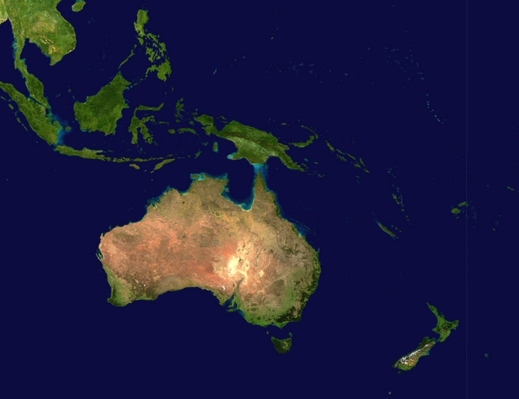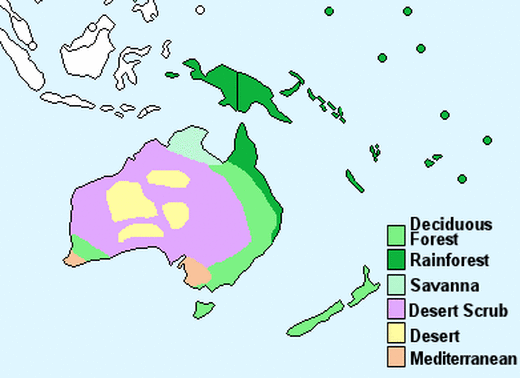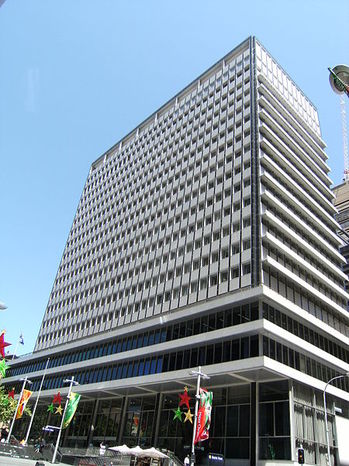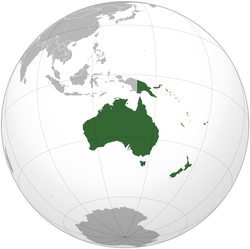Oceania\Australasia
|
Oceania also sometime called Australasia, is the World's smallest continent 8,536,716 km2 covering approximately 5.9% of the Earth's land and 1.5% of the Earth's surface.
Oceania is a name used in geography for the continent made up by Australia, New Zealand, New Guinea, and several other island nations in the surrounding area. Some people call this part of the world Australasia instead.
Sometimes, people use the name Oceania to include only the Polynesian and Melanesian islands in the Pacific Ocean, as separate from "Australasia"
Conceptions of what constitutes Oceania range from the coral atolls and volcanic islands of the South Pacific (Ethnologically divided into the subregions of Melanesia, Micronesia, and Polynesia) to the entire insular region between Asia and the Americas, including Australia,New Zealand and the Malay Archipelago.The term is sometimes used more specifically to denote a continent comprising Australia Continent and proximate islands or biogeographically as a synonym for either the Australasian ecozone (Wallacea and Australasia) or the Pacific ecozone (Melanesia, Polynesia, and Micronesia apart either from New Zealand or from mainland New Guinea.
Oceania is a name used in geography for the continent made up by Australia, New Zealand, New Guinea, and several other island nations in the surrounding area. Some people call this part of the world Australasia instead.
Sometimes, people use the name Oceania to include only the Polynesian and Melanesian islands in the Pacific Ocean, as separate from "Australasia"
Conceptions of what constitutes Oceania range from the coral atolls and volcanic islands of the South Pacific (Ethnologically divided into the subregions of Melanesia, Micronesia, and Polynesia) to the entire insular region between Asia and the Americas, including Australia,New Zealand and the Malay Archipelago.The term is sometimes used more specifically to denote a continent comprising Australia Continent and proximate islands or biogeographically as a synonym for either the Australasian ecozone (Wallacea and Australasia) or the Pacific ecozone (Melanesia, Polynesia, and Micronesia apart either from New Zealand or from mainland New Guinea.
Geography of Oceania

In terms of its physical geography, the islands of Oceania are often divided into four different sub-regions based on the geologic processes playing a role in their physical development. The first of these is Australia. It is separated because of its location in the middle of the Indo-Australian Plate and the fact that due to its location there was no mountain building during its development. Instead, Australia's current physical landscape features were formed by mainly by erosion.
The second landscape category in Oceania is the islands found on the collision boundaries between the Earth's crustal plates. These are found specifically in the South Pacific. For example at the collision boundary between the Indo-Australian and Pacific plates are places like New Zealand, Papua New Guinea and the Solomon Islands. The North Pacific portion of Oceania also features these types landscapes along the Eurasian and Pacific plates. These plate collisions are responsible for the formation of mountains like those in New Zealand which climb to over 10,000 feet (3,000 m).
Volcanic islands such as Fiji are the third category of landscape types found in Oceania. These islands typically rise from the seafloor through hotspots in the Pacific Ocean basin. Most of these areas consist of very small islands with high mountain ranges.Finally, coral reef islands and atolls such as Tuvalu are the last type of landscape found in Oceania. Atolls specifically are responsible for the formation of low-lying land regions, some with enclosed lagoons.
The second landscape category in Oceania is the islands found on the collision boundaries between the Earth's crustal plates. These are found specifically in the South Pacific. For example at the collision boundary between the Indo-Australian and Pacific plates are places like New Zealand, Papua New Guinea and the Solomon Islands. The North Pacific portion of Oceania also features these types landscapes along the Eurasian and Pacific plates. These plate collisions are responsible for the formation of mountains like those in New Zealand which climb to over 10,000 feet (3,000 m).
Volcanic islands such as Fiji are the third category of landscape types found in Oceania. These islands typically rise from the seafloor through hotspots in the Pacific Ocean basin. Most of these areas consist of very small islands with high mountain ranges.Finally, coral reef islands and atolls such as Tuvalu are the last type of landscape found in Oceania. Atolls specifically are responsible for the formation of low-lying land regions, some with enclosed lagoons.
Climate of Australasia/Oceania

The climate of Australasia/Oceania can be divided into six different climate types
- Deciduous forest - Four distinct seasons with warm summers and cold, wet winters. The trees shed their leaves in autumn.
- Rainforest - High temperatures throughout the year with very little rainfall.
- Savanna - Very high temperatures all year and rain during the summer season only.
- Desert - Warm to high temperatures with very little rainfall.
- Desert scrub - Hot summers and cold winters with above average rainfall.
History of Oceania

Ferdinand Magellan (1480 – April 27 1521)
The History of Oceania is the history of Australia, New Zealand, Papua New Guinea, Fiji and other Pacific island nations.
Australia was settled by the Indigenous Australians between 40,000 to 60,000 years ago, but possibly as early as 70,000 years ago. Oceania was first settled by the Polynesian people around 2,000 years ago.
The Tu'i Tonga Empire was founded in the 10th century AD and expanded between 1200 and 1500. The Tu'i Kanokupolu is the title held by Tongan monarchs since 1600. George Tupou II of Tonga became the first king of Tonga in 1893.
From the 1850s Seru Epenisa Cakobau tried to unite the Fijian Islands, and became the first Tui Viti, or king of Fiji, a title which passed to the British Crown after 1874. The Great Council of Chiefs was established in Fiji in 1876.
Oceania was explored by Europeans from the 16th century onwards, the Spanish, with Ferdinand Magellan Fernando de Magallanes in the expedition circunnavegaría the world for the first time, discovered the Marianas and other islands of Oceania. Abel Tasman's voyages in the 1640s visiting north-western Australia, Tasmania, New Zealand, Tonga and the Fijian islands. James Cook explored the Pacific islands and the east coast of Australia in the 18th century.
In 1789 the Mutiny on the Bounty against William Bligh led to several of the mutineers escaping the Royal Navy and settling on Pitcairn Islands, which later became a British colony.
The British followed with colonies in Australia in 1788, New Zealand in 1840 and Fiji in 1872, with much of Oceania becoming part of the British Empire. Other European powers also controlled parts of Oceania,with French New Caledonia from 1853 and French Polynesia from 1889, while the Germans established colonies in New Guinea in 1884, and Samoa in 1900. The United States also expanded into the Pacific, beginning with Baker Island and Howland Island in 1857, and with Hawaii becoming a U.S. territory from 1898. Disagreements between the US, Germany and UK over Samoa led to the Tripartite Convention of 1899. Among the last islands to be colonised were Tonga and Niue (1900) and Manu'a (1904).
During the First World War the German colonies in the Pacific were taken over by Allied powers. In the Second World War the Japanese invaded New Guinea, the Solomon Islands and other Pacific islands. They were turned back at the Battle of the Coral Sea and the Kokoda Track campaign before they were finally defeated in 1945.
Australia and New Zealand became dominions in the 20th century, adopting the Statute of Westminster Act in 1942 and 1947 respectively, marking their legislative independence from the United Kingdom. Hawaii became a U.S. state in 1959. Fiji and Tonga became independent in 1970, with many other nations following in the 1970s and 1980s. The South Pacific Forum was founded in 1971, which became the Pacific Islands Forum in 2000. Bougainville Island, geographically part of the Solomon Islands but politically part of Papua New Guinea, tried unsuccessfully to become independent in 1975, and a civil war followed in the early 1990s, with it later being granted autonomy.
French nuclear testing in the Pacific was controversial in the 1980s, in 1985 French agents caused the Sinking of the Rainbow Warrior in Auckland to prevent it from arriving at the test site in Moruroa.
East Timor declared independence from Portugal in 1975, but was invaded by Indonesia, before it was granted full independence in 2002. Fiji has had a troubled recent history with coups in 1987, 2000 and 2006. Between 2001 and 2007 Australia's Pacific Solution policy transferred asylum seekers to several Pacific nations, including the Nauru detention centre. Australia, New Zealand and other nations took part in the Regional Assistance Mission to Solomon Islands from 2003 after a request for aid. Global warming is an issue in present day Oceania with many countries having droughts and storms.
Australia was settled by the Indigenous Australians between 40,000 to 60,000 years ago, but possibly as early as 70,000 years ago. Oceania was first settled by the Polynesian people around 2,000 years ago.
The Tu'i Tonga Empire was founded in the 10th century AD and expanded between 1200 and 1500. The Tu'i Kanokupolu is the title held by Tongan monarchs since 1600. George Tupou II of Tonga became the first king of Tonga in 1893.
From the 1850s Seru Epenisa Cakobau tried to unite the Fijian Islands, and became the first Tui Viti, or king of Fiji, a title which passed to the British Crown after 1874. The Great Council of Chiefs was established in Fiji in 1876.
Oceania was explored by Europeans from the 16th century onwards, the Spanish, with Ferdinand Magellan Fernando de Magallanes in the expedition circunnavegaría the world for the first time, discovered the Marianas and other islands of Oceania. Abel Tasman's voyages in the 1640s visiting north-western Australia, Tasmania, New Zealand, Tonga and the Fijian islands. James Cook explored the Pacific islands and the east coast of Australia in the 18th century.
In 1789 the Mutiny on the Bounty against William Bligh led to several of the mutineers escaping the Royal Navy and settling on Pitcairn Islands, which later became a British colony.
The British followed with colonies in Australia in 1788, New Zealand in 1840 and Fiji in 1872, with much of Oceania becoming part of the British Empire. Other European powers also controlled parts of Oceania,with French New Caledonia from 1853 and French Polynesia from 1889, while the Germans established colonies in New Guinea in 1884, and Samoa in 1900. The United States also expanded into the Pacific, beginning with Baker Island and Howland Island in 1857, and with Hawaii becoming a U.S. territory from 1898. Disagreements between the US, Germany and UK over Samoa led to the Tripartite Convention of 1899. Among the last islands to be colonised were Tonga and Niue (1900) and Manu'a (1904).
During the First World War the German colonies in the Pacific were taken over by Allied powers. In the Second World War the Japanese invaded New Guinea, the Solomon Islands and other Pacific islands. They were turned back at the Battle of the Coral Sea and the Kokoda Track campaign before they were finally defeated in 1945.
Australia and New Zealand became dominions in the 20th century, adopting the Statute of Westminster Act in 1942 and 1947 respectively, marking their legislative independence from the United Kingdom. Hawaii became a U.S. state in 1959. Fiji and Tonga became independent in 1970, with many other nations following in the 1970s and 1980s. The South Pacific Forum was founded in 1971, which became the Pacific Islands Forum in 2000. Bougainville Island, geographically part of the Solomon Islands but politically part of Papua New Guinea, tried unsuccessfully to become independent in 1975, and a civil war followed in the early 1990s, with it later being granted autonomy.
French nuclear testing in the Pacific was controversial in the 1980s, in 1985 French agents caused the Sinking of the Rainbow Warrior in Auckland to prevent it from arriving at the test site in Moruroa.
East Timor declared independence from Portugal in 1975, but was invaded by Indonesia, before it was granted full independence in 2002. Fiji has had a troubled recent history with coups in 1987, 2000 and 2006. Between 2001 and 2007 Australia's Pacific Solution policy transferred asylum seekers to several Pacific nations, including the Nauru detention centre. Australia, New Zealand and other nations took part in the Regional Assistance Mission to Solomon Islands from 2003 after a request for aid. Global warming is an issue in present day Oceania with many countries having droughts and storms.
Countries and territories in Oceania
|
|
Economy of Oceania

Reserve Bank of Australia-Central Bank
The economy of Oceania comprises more than 14 separate countries and their associated economies.
On a total scale the region has approximately 34,700,201 [2010] inhabitants who are spread among 30,000 islands in the South Pacific bordered between Asia and the Americas. This region has a diverse mix of economies from the highly developed and globally competitive financial markets of Australia (1st) and New Zealand (2nd) boasting parity with much of Western Europe, to the much less developed economies that belong to many of their island neighbours.
Many of the smaller Pacific nations rely on trade with Australia, New Zealand and the United States for exporting goods and for accessing other products.The overwhelming majority of people living in Oceania work in the service industry which includes tourism, education and financial services. Oceania's largest export markets include Japan, China, the United States and South Korea.
Tourism has become a large source of income for many in the Pacific; tourists come from Australia, New Zealand, Japan, the United Kingdom and the USA. Fiji currently draws almost half a million tourists each year; more than a quarter from Australia. This contributes $1 billion dollars or more since 1995 to Fiji's economy but the Government of Fiji islands underestimate these figures due to invisible economy inside tourism industry.
Agriculture and natural resources constitutes only 5% to 10% of Oceania's total jobs, but contributes substantially to export performance. The most populous two nations, Australia and New Zealand, are also the most developed and have majority service industries. This dilutes the data from the less developed Pacific Island nations who have major agricultural economies. Most of the Pacific countries (excluding Australia and New Zealand) the primary industry is agriculture. Many nations are still quintessentially agricultural; for example, 80% of the population of Vanuatu and 70% of the population of Fiji works in agriculture. The main produce from the pacific is copra or coconut, but timber, beef, palm oil, cocoa, sugar and ginger are also commonly grown across the tropics of the Pacific. Fishing provides a major industry for many of the smaller nations in the Pacific, although many fishing areas are exploited by other larger countries, namely Japan. Natural Resources, such as lead, zinc, nickel and gold, are mined across the West of the region, in Australia and the Solomon Islands. Oceania's largest export markets include Japan, China, the United States and South Korea.
On a total scale the region has approximately 34,700,201 [2010] inhabitants who are spread among 30,000 islands in the South Pacific bordered between Asia and the Americas. This region has a diverse mix of economies from the highly developed and globally competitive financial markets of Australia (1st) and New Zealand (2nd) boasting parity with much of Western Europe, to the much less developed economies that belong to many of their island neighbours.
Many of the smaller Pacific nations rely on trade with Australia, New Zealand and the United States for exporting goods and for accessing other products.The overwhelming majority of people living in Oceania work in the service industry which includes tourism, education and financial services. Oceania's largest export markets include Japan, China, the United States and South Korea.
Tourism has become a large source of income for many in the Pacific; tourists come from Australia, New Zealand, Japan, the United Kingdom and the USA. Fiji currently draws almost half a million tourists each year; more than a quarter from Australia. This contributes $1 billion dollars or more since 1995 to Fiji's economy but the Government of Fiji islands underestimate these figures due to invisible economy inside tourism industry.
Agriculture and natural resources constitutes only 5% to 10% of Oceania's total jobs, but contributes substantially to export performance. The most populous two nations, Australia and New Zealand, are also the most developed and have majority service industries. This dilutes the data from the less developed Pacific Island nations who have major agricultural economies. Most of the Pacific countries (excluding Australia and New Zealand) the primary industry is agriculture. Many nations are still quintessentially agricultural; for example, 80% of the population of Vanuatu and 70% of the population of Fiji works in agriculture. The main produce from the pacific is copra or coconut, but timber, beef, palm oil, cocoa, sugar and ginger are also commonly grown across the tropics of the Pacific. Fishing provides a major industry for many of the smaller nations in the Pacific, although many fishing areas are exploited by other larger countries, namely Japan. Natural Resources, such as lead, zinc, nickel and gold, are mined across the West of the region, in Australia and the Solomon Islands. Oceania's largest export markets include Japan, China, the United States and South Korea.


